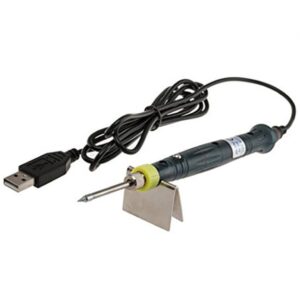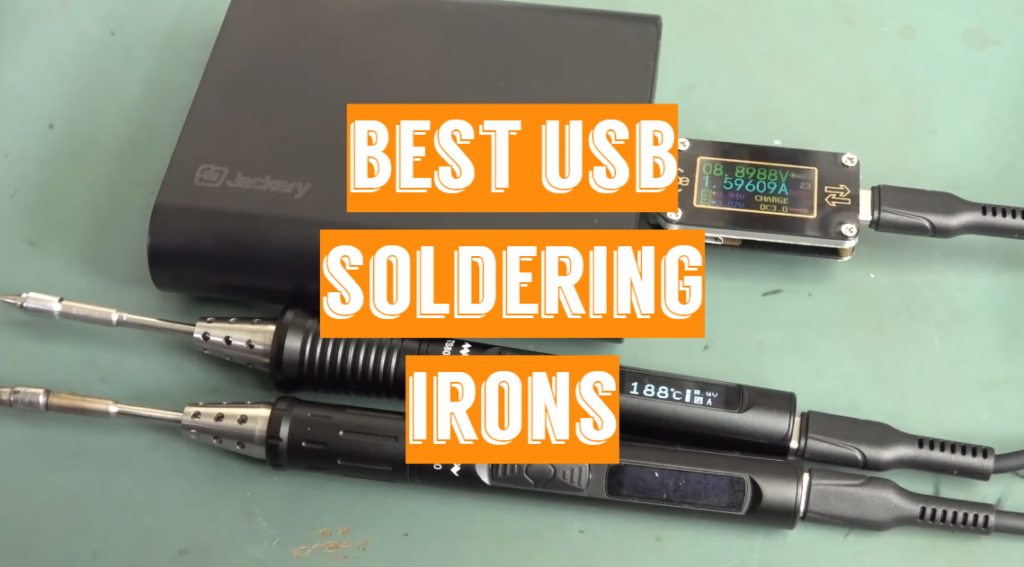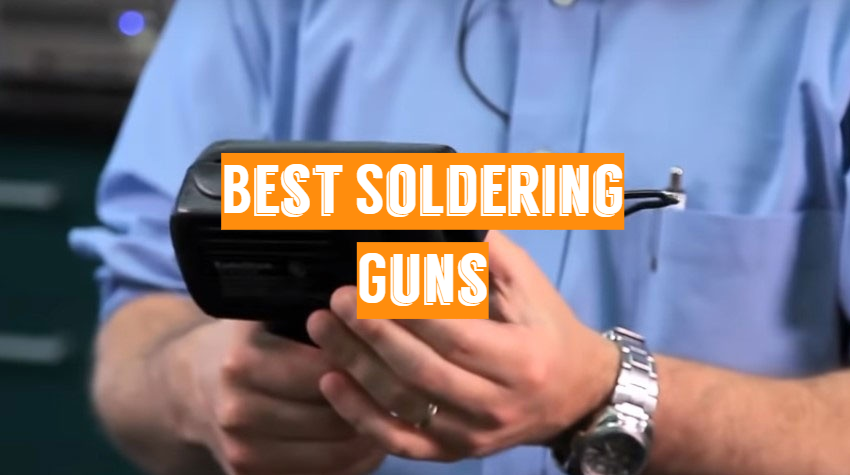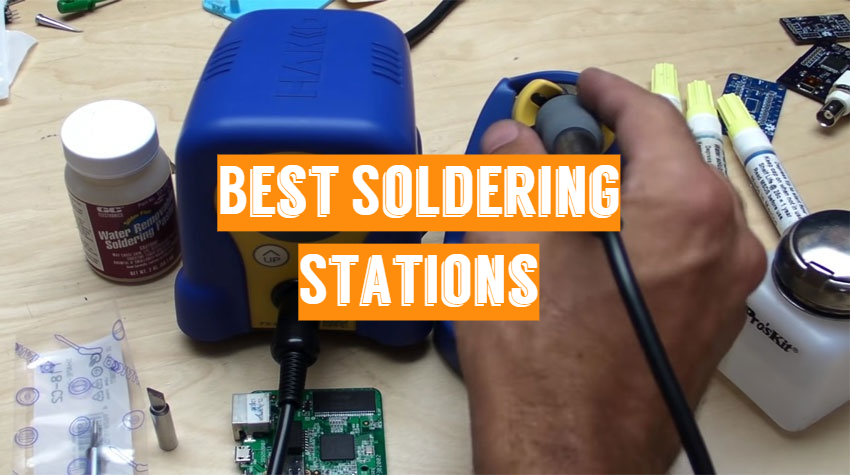




Customer’s Choice: the Best Rated USB Soldering Irons
[survey_answers id=”1874119167″ style=”plain” data=”score”] users answered this survey. Please help us improve this review!
[survey_answers id=”1874119167″ style=”piechart” legend=”true”]
Premium USB soldering irons are one of those tools that nearly everyone needs to use from time to time. Whether you’re a hobbyist, an electrician, or just need it for the occasional fix-it project around the house, being able to solder is a vital skill. So what do you look for in a USB soldering iron? This guide will answer that question as well as give reviews and tips about some of the best USB soldering irons on the market today!
UY CHAN Upgraded TS80P Digital OLED Mini Soldering Station Kit – the Editor’s choice!
 This digital soldering station is perfect for home use as well as in the field. At home, plug it into a power adapter and enjoy a hands-off temperature setting with an OLED screen that will show you accurate temperatures of up to 752F!
This digital soldering station is perfect for home use as well as in the field. At home, plug it into a power adapter and enjoy a hands-off temperature setting with an OLED screen that will show you accurate temperatures of up to 752F!
On the go, charge up the TS80P so you can solder on your favorite FPV multirotor when it’s down without hesitation.
The TS80P can be powered up by a PD2.0 or QC3.0 Adapter and has two temperature sensors that are easy to calibrate and adjust.
Versatile, smart & safe – all these words describe this mini soldering station that features infrared dual-temperature sensors and accelerated thermal shutdown.
Pros
- Includes an adapter;
- Portable;
- Quick heating;
- Dual-temperature sensor;
Cons
- The tip may not be inserted into the base;
- Only 2 tips for it;
The TS80P digital soldering station kit is perfect for any electronics enthusiast. It’s specially designed for fixing the FPV multirotor according to your specs, so you don’t have to worry about it at all!
Nameo Professional Portable USB Powered Soldering Iron Pen – the best for the price!
 This Nameo USB Portable Soldering Pen is awesome for on-the-go repairs and projects! With a lifetime warranty, an LED indicator that lights up when the pen is in use to let them know their making progress quickly.
This Nameo USB Portable Soldering Pen is awesome for on-the-go repairs and projects! With a lifetime warranty, an LED indicator that lights up when the pen is in use to let them know their making progress quickly.
This pen has been designed not only to get hot quickly but cools down just as fast too so there’s no more waiting around for it to heat up again as those bulky old fashioned ones do. Also, it has a protective cap, so hands never touch the tip of the iron!
Pros
- Budget-friendly;
- Portable;
- Multi-functional;
- Heats in less than 15 seconds;
- Includes a protective cap;
Cons
- Flimsy;
- Wonky auto-shutoff;
This Nameo mini USB-powered portable soldering iron pen heats up in less than 15 seconds and cools down in less than 30 seconds for quick starts on tasks! With an LED indicator light that turns red when it reaches the desired temperature. You’ll be able to take this with you anywhere!
QY 8W 5V USB Powered Mini Professional Soldering Pen – the best for small repairs!
 The QY 8W 5V USB Powered Mini Professional Soldering Pen will solve all your issues when you need some small professional repairs since it’s compact but still has big power! It’s been engineered to be incredibly safe and will automatically power off after being idle for fifteen minutes.
The QY 8W 5V USB Powered Mini Professional Soldering Pen will solve all your issues when you need some small professional repairs since it’s compact but still has big power! It’s been engineered to be incredibly safe and will automatically power off after being idle for fifteen minutes.
With a powerful 8W heating element, it warms up in just 15 seconds and never overheats so you can forget about worrying about your projects. The lighted end makes soldering tinned wire quick and easy while the lines on the sides help solder to metal conductors or tinned wires with precision. A stand is included as well as cleaning cloth and wax making it perfect for work at home or just tinkering around.
Pros
- Compact and small;
- Great for small repairs;
- The LED light indicator;
- Safe;
- Includes a metal stand;
Cons
- No battery power;
- The power jack comes off easily;
Transform the heat of your soldering iron from an unbearable to a manageable level with this super handy 8W USB-powered mini professional soldering pen. Warms up in no time, so you can get right back to what matters most – repairing or creating plans and ideas! Its small size makes it perfect for when you need some quick soldering on the go.
Rongon 5V 8W Portable USB Soldering Iron Pen – the best for quick heating!
 The Rongon 5V 8W Portable USB Soldering Iron Pen is the perfect little pen for your soldering needs. It has a small tip that will come in handy when working with tiny chips and other small jobs like SMD work.
The Rongon 5V 8W Portable USB Soldering Iron Pen is the perfect little pen for your soldering needs. It has a small tip that will come in handy when working with tiny chips and other small jobs like SMD work.
The ergonomic design of the handle makes using this pen extremely comfortable, so you’ll be able to get the job done quickly and effortlessly.
The pen features a long lifespan tip with a protective cap, momentary trigger powers unit on, ergonomic design- easy to use. This portable device has a rapid heat-up time (less than 15 seconds), so you can get your work done faster than ever before.
It also comes with an LED light that shuts off after 25 seconds if it isn’t being used to save power while still producing heat from its copper wire heating element.
Pros
- Quickly heats;
- Multi-functional;
- Portable and compact;
- Durable tips;
- Good for SMD work;
Cons
- The design can be better;
- The handle may get very hot;
This USB soldering iron pen can be perfect for hobbyists, as it doesn’t take up much space on your toolbox or desk!
Gouptec Hot Portable USB Power Soldering Iron – the best for safety!
 This USB power soldering iron is a must-have for any project, at home or on the job! It has rubber grips to make it a comfortable and cool design so that it can be portable. The device has an 8-watt input making it perfect for lightweight work.
This USB power soldering iron is a must-have for any project, at home or on the job! It has rubber grips to make it a comfortable and cool design so that it can be portable. The device has an 8-watt input making it perfect for lightweight work.
When you’re done using your Gouptec Hot Portable USB Power Soldering Iron, just let it rest and cool down, in under 30 seconds.
This product will make your life easier with its instant recovery and no need for an AC adapter. The soldering iron is small and compact so you can take it anywhere. Its long-lasting tip comes with a protective cap to be safe when not in use.
Pros
- Rubber base and handle;
- Durable;
- Includes a protective cap;
- Cools down in 30 seconds;
- The tips are easy to replace;
Cons
- Heats slowly;
- Flimsy build;
This safe USB-powered soldering iron can help you get your home-wiring job done in less time. It’s compact and portable for easy use on short jobs, the Gouptec has an instant recovery mode so it never wastes any of your valuable time.
The Buyer’s Guide
What is a USB Soldering Iron?
A USB soldering iron is a small, lightweight soldering tool that plugs directly into an available USB port on your computer or motherboard to power itself. What you can do with these tools is limited, but they are often used for surface-mounted devices (SMD) and through-hole components in electronics projects and repairs. They typically come in pen shapes resembling large pens rather than the traditional gun shape of non-USB models that require external power sources plugged into electrical sockets.
The benefit of using this type of solder iron over other types would be its versatility as well as its convenience. You wouldn’t need to worry about connecting it to a free socket every time you wanted to use it with no possibility of forgetting one day to plug the soldering iron at the required current, which means you’ll have to make sure your computer or motherboard has enough juice before purchasing one.
The downside of using this type is that not all USB ports are able to power a USB soldering iron. This is because the power output of a computer or motherboard may not be enough to handle both the device and all other devices connected at that time, which means you’ll need to research your own machine’s capabilities before purchasing one so as not to end up with an underpowered tool in terms of temperature control.
The other issue with these tools would be their unpredictability when it comes to temperature control as they often lack an on/off switch or adjustable heat dials and usually only output either too high of a temperature for some materials or too low of a temperature for others. It depends on how much charge was left in them when plugged in – so if precision work is important then investing in something more expensive might be worth considering.
The average price for this type is usually anywhere from $15-25 depending on where you buy it from. One last thing – though most of these come without any sort of warranty attached to them, some people have said they’ve found success contacting manufacturer support directly if something goes wrong after purchase (though there are no guarantees).
How to Use a USB Soldering Iron?
The USB soldering irons come with a cord that is typically plugged into an outlet or power strip.
Once the device is plugged in, it will start to heat up and it may take about 20 seconds for the iron to get hot enough for use.
When you are ready to solder two pieces of metal together, make sure both surfaces are clean before starting on one side of the connection and then moving over each area until they meet at the other end. The hotter areas should be placed against colder ones if possible so as not to cause undue stress on either surface while joining them together.
It can also help when using more than one piece of metal by connecting opposite ends first before adding another section. Be mindful not to leave the soldering iron on one spot for too long to avoid heat damage.
Here is how you should use any USB-powered soldering iron:
1) The first step of using any kind of soldering tool is cleaning the tip and tinning it with a solder that has not yet been used. There will be no icky oxide or anything on the tip when you start working, which can make your work go much more smoothly. This also helps prevent damaging the component being worked on. To do this, just put a tiny bit of new solder onto an old one (use lead-free) and then place them both into the flame for about 20 seconds before wiping off all excess liquid metal with a wet sponge or cloth. Do not let either have too much time in contact with oxygen because they will oxidize and become unusable.
2) If you have never tinned a soldering iron before, it is an easy process that consists of just applying solder to both the tip of your tool as well as a scrap piece of copper wire. The whole point is for them each to be covered with liquid metal so they will not oxidize or anything when in contact with air which can happen very easily if they are left uncoated; this way the two pieces stay active until their next use (even though some might say that tinning should only be done every few weeks).
FAQ
Are USB soldering irons any good?
USB soldering irons are not as powerful or convenient as their corded counterparts but do offer some benefits. The main argument for using a USB soldering iron is that they don’t require an outlet and can be used virtually anywhere with the right adaptor. They also have all sorts of safety features you would find on more expensive models like automatic shut-off to prevent overheating, tips that stop getting hot when idle, and smaller barrel sizes that prevent burns while working in tight quarters.
For hobbyists who need something light enough to carry around regularly, there’s no better option than a battery-powered model. If you’re just starting it may feel less intimidating too because they lack the heftier weight associated with heavier duty tools designed for heavier jobs.
So, USB soldering irons are not as powerful or convenient as their corded counterparts but do offer a few benefits to hobbyists and beginners who need something light enough to carry around regularly.
What temperature should USB soldering iron be for electronics?
A good rule of thumb is to start with a temperature between 400-450F for electronics. This will help you avoid damaging the components on your board or overheating them, which can cause problems like high resistance and failure in production later down the line. If you are unsure what to use as a starting point, consult the manufacturer’s guidelines that come included with each soldering iron set.
How do I know if my USB soldering iron is hot enough?
This question can be answered with the following: the hotter the tip, the better. The best USB soldering irons should have tips that are above 480F and this will allow for more consistent heat distribution on delicate components like PCBs, copper pads, solder-side of board joints, etc. If you’re using your iron to do jobs such as de-soldering or desoldering it’s always important to remember that these operations require higher temperatures (usually between 700 – 800F). Luckily, most quality soldering stations come equipped with adjustable temperature settings that make them perfect for just about any job.
Is a 40-watt USB soldering iron enough?
A 40-watt soldering iron is enough for most projects. However, if you need a lot of heat then these might not be the best option because they don’t put out as hot of an air temperature as 60-100 watt irons do. On top of that, it takes anywhere from 30 seconds to one minute for them to reach their full heating potential which can make some time-consuming tasks more difficult than necessary.
It’s best to use a 40-watt soldering iron for smaller projects like small electronics or PCB boards. If you need something more powerful then it might be worth investing in one of the higher wattage models that are available on this list.
How many watts is a good USB soldering iron?
A good USB soldering iron has at least 15 watts of power. If you are experienced with soldering and have a project in mind that requires more than 100 watts, then you might need to purchase an electric solder gun.
If you are inexperienced with soldering, or if your project is smaller–such as a battery rewire for an electronic toy – then a 15-watt iron will suffice. In general, the more watts of power on your USB soldering iron, the better it will be for larger jobs.
The higher wattage irons can get hotter more quickly and maintain their temperature better than lower wattage models. The downside to those high wattages is that they take longer to reach full heat due to all the extra material inside them.
However, this means they stay hot longer when idle because there is so much metal there absorbing any residual thermal energy leftover from previous use cycles. This feature allows these irons to work for long periods without requiring constant attention or re-heating.
How do I know what wattage my USB soldering iron is?
Wattage is a measure of the power output. The higher the wattage, the more heat your USB soldering iron will produce and can be controlled by any temperature setting on your device. Most people find that anything less than 30 watts doesn’t do well for electronics work or heavy-duty jobs like circuit board solder joints.
For light-duty jobs such as small electronic circuits, touch-up soldering in tight spaces (e.g., around wires), repairing laptop keyboards, etc., you might want to consider buying an around 15 – 20-watt unit. These are available from many brands and offer good value for money if you don’t need high temperatures.
Why did the tip of my USB soldering iron melt?
The tip of a USB soldering iron can melt if you use it to solder for more than 20 minutes without switching the power off. It is best to change out your tips often so they don’t overheat and become useless or dull, as this will affect how well the tool works.
If you are using flux-cored wire, make sure that when you heat the end with the electricity close by, it doesn’t cause any flames because this could severely damage both your surface and the material being worked on. However, not all soldering irons have tips in them – some require additional purchases or attachments!
How do you refresh a USB soldering iron tip?
The simplest way to refresh a USB soldering iron tip is by using the included solder spool. Take the solder off the spool and feed it through your working area, then use an external heat source (the flame from a lighter) to melt some fresh solder onto the end of your wire. This will create new metal that fuses with both ends together so you can continue to work without fear of disconnecting from electricity or melting plastic components.
Video Tutorial: TS80P Portable USB PD Soldering Iron Review
Final Thoughts
So, what does this all mean? Well for starters, not every USB soldering iron is going to fit your needs. You need to know the type of work you’ll be doing with it and how often so that you don’t end up wasting money on something that doesn’t suit your specific purpose. The right tool can make a huge difference in terms of efficiency and quality when completing those DIY projects around the house or fixing electronics. Hopefully, this guide was quite helpful.




I have a USB-C soldering iron, and I’m pretty satisfied with it. However, It doesn’t have a power switch, so I had to unplug it from the wall every time I wanted to turn it off. This is not very green and annoying, especially if you have two USB-C devices plugged into the same outlet strip.
So I decided to install a switch of my own. You can use any SPST or SPDT switch that is rated for at least 5A/125VAC – just look up your switch model number online and be sure your wiring follows electrical code standards.